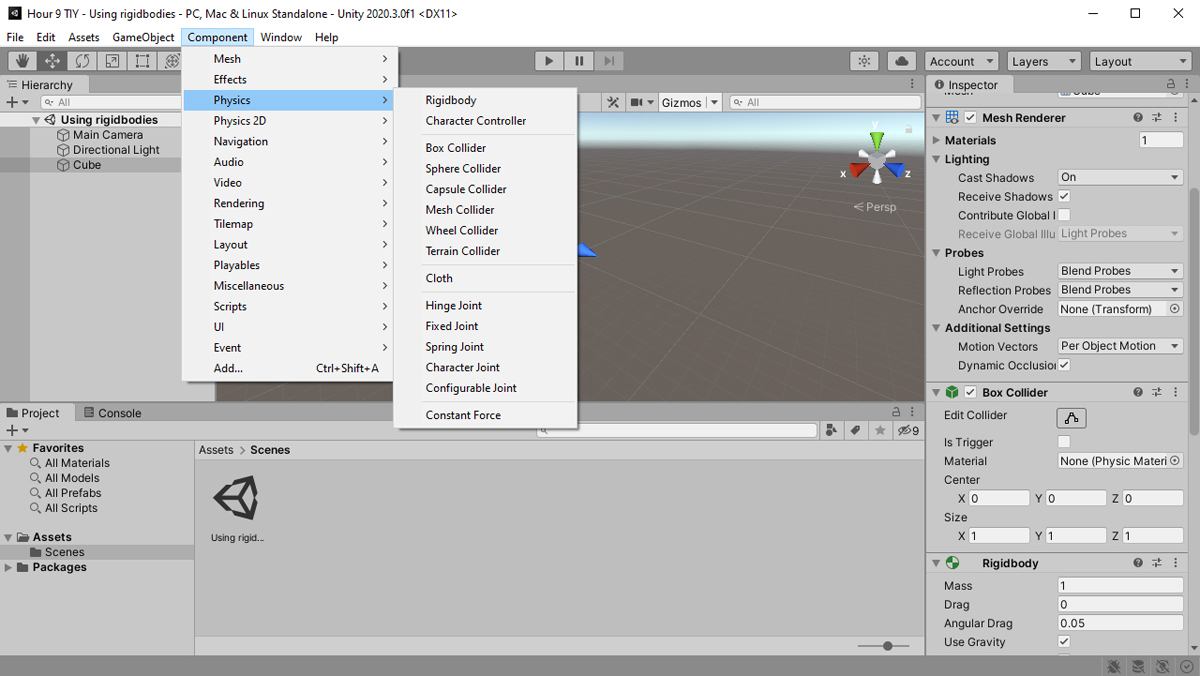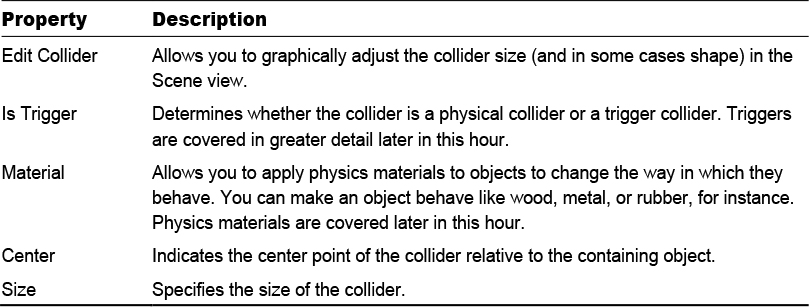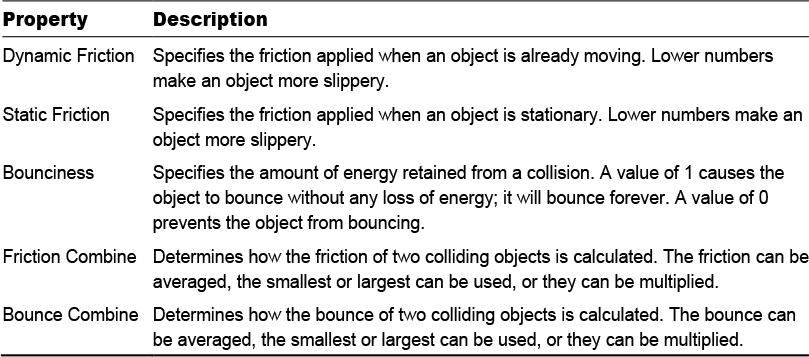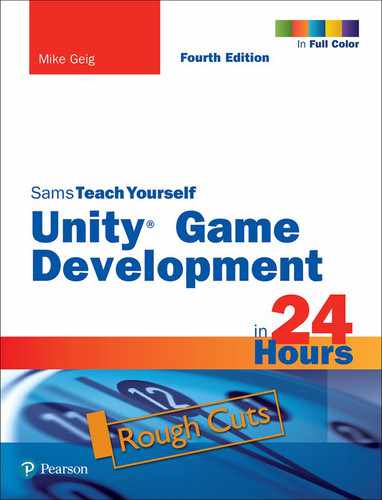Hour 9. Collision
What You’ll Learn in This Hour:
► The basics of rigidbodies
► How to use colliders
► How to script with triggers
► How to raycast
In this hour, you’ll learn to work with the most prevalent physics concept in video games: collision. Collision, simply put, involves knowing when the border of one object has come into contact with another object. You’ll begin by learning what rigidbodies are and what they can do for you. After that, you’ll experiment with Unity’s powerful built-in physics engines—Box2D and PhysX. From there, you’ll learn some more subtle uses of collision with triggers. You’ll end the hour by learning to use a raycast to detect collisions.
Rigidbodies
For objects to take advantage of Unity’s built-in physics engines, they must include a component called a rigidbody. Adding a rigidbody component makes an object behave like a real-world physical entity. To add a rigidbody component, simply select the object that you want (make sure you choose the version without 2D on the end) and click Component > Physics > Rigidbody. The new rigidbody component is added to the object in the Inspector (see Figure 9.1).

FIGURE 9.1
The rigidbody component.
The rigidbody component has several properties that you have not seen yet. Table 9.1 describes them.
TABLE 9.1 Rigidbody Properties

Enabling Collision
Now that you have objects moving around, it is time to start getting them to crash into each other. For objects to detect collision, they need a component called a collider. A collider is a perimeter that is projected around an object that can detect when other objects enter it.
Colliders
Geometric objects such as spheres, capsules, and cubes already have collider components on them when they are created. You can add a collider to an object that doesn’t have one by selecting Component > Physics and then choosing the collider shape you want from the menu. Figure 9.2 shows the various collider shapes you can choose from.

FIGURE 9.2
The available colliders.
Once a collider is added to an object, the collider object appears in the Inspector. Table 9.2 describes the collider properties. In addition to these, if a collider is a sphere or capsule, you might have an additional property, such as Radius. These geometric properties behave exactly as you would expect them to.
TABLE 9.2 Collider Properties

Physics Materials
Physics materials can be applied to colliders to give objects varied physical properties. For instance, you can use a rubber material to make an object bouncy or an ice material to make it slippery. You can even make your own physics materials to emulate specific materials of your choosing.
There are some premade physics materials in the book files for Hour 9. To import them, locate the file Physics Materials.unitypackage and drag it into your project. Ensure all items are selected in the import dialog and click Import. This adds an AssetsPhysicsMaterials folder in your project that contains several physics materials with descriptive names. You can also create your own physics materials. To create a new physics material, right-click the Assets folder in the Project view and select Create > Physic Material or Create > 2D > Physics Material 2D (if you’re working with 2D physics, covered in Hour 12, “2D Game Tools”).
A physics material has a set of properties that determine how it behaves on a physical level (see Figure 9.3). Table 9.3 describes the physics material properties. You can apply a physics material to an object by dragging it from the Project view onto an object with a collider.

FIGURE 9.3
The properties of physics materials.
TABLE 9.3 Physics Material Properties

The effects of a physics material can be as subtle or as distinct as you like. Try it out for yourself and see what kinds of interesting behaviors you can create.
Triggers
So far, you have seen physical colliders—colliders that react in a positional and rotational fashion using Unity’s built-in physics engine. If you think back to Hour 6, “Game 1: Amazing Racer,” however, you can probably remember using another type of collider. Remember how the game detected when the player entered the water hazards and finish zone? That was the trigger collider at work. A trigger detects collision just like normal colliders do, but it doesn’t do anything specific about it. Instead, triggers call three specific methods that allow you, the programmer, to determine what the collision means:
void OnTriggerEnter(Collider other) // is called when an object enters the trigger void OnTriggerStay(Collider other) // is called while an object stays in the trigger void OnTriggerExit(Collider other) // is called when an object exits the trigger
Using these methods, you can define what happens whenever an object enters, stays in, or leaves the collider. For example, if you want to write a message to the Console whenever an object enters the perimeter of a cube, you can add a trigger to the cube. Then you attach a script to the cube with the following code:
void OnTriggerEnter(Collider other)
{
print("Object has entered collider");
}
You might notice the one parameter to the trigger methods: the variable other of type Collider. This is a reference to the object that entered the trigger. Using that variable, you can manipulate the object however you want. For instance, to modify the preceding code to write to the Console the name of the object that enters the trigger, you can use the following:
void OnTriggerEnter(Collider other)
{
print(other.gameObject.name + " has entered the trigger");
}
You could even go so far as to destroy the object entering the trigger with some code like this:
void OnTriggerEnter(Collider other)
{
Destroy(other.gameObject);
}
Raycasting
Raycasting is the act of sending out an imaginary line, called a ray, and seeing what it hits. Imagine, for instance, looking through a telescope. Your line of sight is the ray, and whatever you can see at the other end is what your ray hits. Game developers use raycasting all the time for things like aiming, determining line of sight, gauging distance, and more. There are a few Raycast methods in Unity. The two most common uses are laid out here. The first Raycast method looks like this:
bool Raycast(Vector3 origin, Vector3 direction, float distance, LayerMask mask);
Notice that this method takes quite a few parameters. Also notice that it uses a variable called Vector3 (which you’ve used before). Vector3 is a variable type that holds three floats inside it. Using it is a great way to specify x, y, and z coordinates without requiring three separate variables. The first parameter, origin, is the position at which the ray starts. The second, direction, is the direction in which the ray travels. The third parameter, distance, determines how far out the ray will go, and the final variable, mask, determines what layers will be hit. You can omit both the distance and the mask variables. If you do, the ray will travel an infinite (or very far, in this case) distance and hit all object layers.
As mentioned earlier, there are many things you can do with rays. If you want to determine whether something is in front of the camera, for example, you can attach a script with the following code:
void Update()
{
// cast the ray from the camera’s position in the forward direction
if (Physics.Raycast(transform.position, transform.forward, 10))
print("There is something in front of the camera!");
}
Another way you can use this method is to find the object that the ray collided with. This version of the method uses a special variable type called RaycastHit. Many versions of the Raycast method use distance (or don’t) and layer mask (or don’t). The most basic way to use this version of the method, though, looks something like this:
bool Raycast(Vector3 origin, Vector3 direction, out Raycast hit, float distance);
There is one new interesting thing about this version of the method. You might have noticed that it uses a new keyword that you have not seen before: out. This keyword means that when the method is done running, the variable hit will contain whatever object was hit. The method effectively sends the value back out when it is done. It works this way because the Raycast() method already returns a Boolean variable that indicates whether it hit something. Since a method cannot return two variables, you use out to get more information.
Summary
In this hour, you have learned about object interactions through collision. First, you learned about the basics of Unity’s physics capabilities with rigidbodies. Then you worked with various types of colliders and collision. From there, you learned that collision is more than just stuff bouncing around, and you got hands-on with triggers. Finally, you learned to find objects by using raycasting.
Q&A
Q. Should all my objects have rigidbodies?
A. Rigidbodies are useful components that serve largely physical roles. That said, adding rigidbodies to every object can have strange side effects and may reduce performance. A good rule of thumb is to add components only when they are needed and not preemptively.
Q. There are several colliders we didn’t talk about. Why not?
A. Most colliders either behave the same way as the ones covered here or are beyond the scope of this text (and are, therefore, omitted). Suffice it to say that this text still provides what you need to know to make some very fun games.
Workshop
Take some time to work through the questions here to ensure that you have a firm grasp of the material.
Quiz
1. What component is required on an object if you want it to exhibit physical traits such as falling?
2. True or False: An object can have only a single collider on it.
3. What sorts of things are raycasts useful for?
Answers
1. Rigidbody
2. False. An object can have many, and varied, colliders on it.
3. Determining what an object can see and finding objects along line of sight as well as finding distances between objects
Exercise
In this exercise, you’ll create an interactive application that uses motion and triggers. The exercise requires you to creatively determine a solution (because one is not presented here). If you get stuck and need help, you can find the solution to this exercise, called Hour 9 Exercise, in the book assets for Hour 9.
1. Create a new project or scene. Add a cube to the scene and position it at (–1.5, 0, –5). Scale the cube to (.1, 2, 2) and rename it LTrigger.
2. Duplicate the cube (by right-clicking the cube in the Hierarchy view and selecting Duplicate). Name the new cube RTrigger and place it at (1.5, 0, –5.)
3. Add a sphere to your scene and place it at (0, 0, –5). Add a rigidbody to the sphere and uncheck Use Gravity.
4. Create a script named TriggerScript and place it on both LTrigger and RTrigger. Create a script called MotionScript and place it on the sphere.
5. Now comes the fun part. You need to create the following functionality in your application:
► The player should be able to move the sphere with the arrow keys.
► When the sphere enters, exits, or stays in either of the triggers, the corresponding message should be written to the Console. The message should indicate which of the three it is and the name of the trigger that the sphere collided with (LTrigger or RTrigger).
► There is a hidden “gotcha” built into this exercise that you need to overcome in order to make this work.
Good luck!

